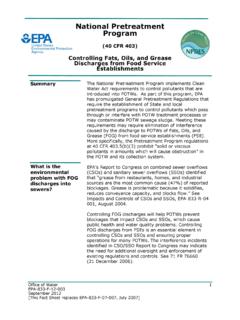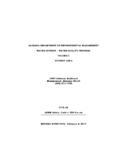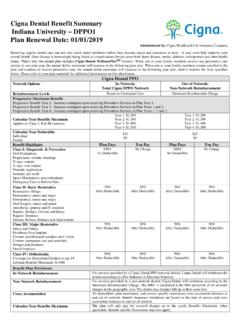Transcription of Introduction to the National Pretreatment Program
1 Disclaimer DISCLAIMER. The discussion in this document is intended solely as a summary of existing guidance. This document is not a regulation, nor does it substitute for any requirements under the Clean Water Act (CWA) or Environmental Protection Agency's (EPA's) regulations. Thus, it does not impose legally binding requirements on EPA, states, municipalities, or the regulated community. The general descriptions provided in this document might not apply to a particular situation based on the circumstances.
2 This document does not confer legal rights or impose legal obligations on any member of the public. Among other things, the document describes existing requirements with respect to industrial dischargers and publicly owned treatment works (POTWs) under the CWA and its implementing regulations at Title 40 of the Code of Federal Regulations, Parts 122, 123, 124, and 403 and chapter I, subchapter N. Although EPA has made every effort to ensure the accuracy of the discussion in this document, a discharger's obligations are determined, in the case of directly discharging POTWs, by the terms of its National Pollutant Discharge Elimination System permit and EPA's regulations or, in the case of indirect dischargers, by permits or equivalent control mechanisms issued to POTW industrial users or by regulatory requirements.
3 Nothing in this document changes any statutory or regulatory requirement. If a conflict arises between this document's content and any permit or regulation, the permit or regulation would be controlling. EPA and local decision makers retain the discretion to adopt approaches on a case- by-case basis that differ from those described in this document where appropriate and authorized by EPA. regulations, state law, or local ordinances. Mention of trade names or commercial products does not constitute endorsement or recommendation for their use.
4 This document is current as of March 2011. EPA may decide to revise this document without public notice to reflect changes in the Agency's approach to implementing Pretreatment standards or to clarify and update text. To determine whether EPA has revised or supplemented the information in this document, access the document at Introduction to the National Pretreatment Program Contents CONTENTS. CHAPTER 1. POTWs and the Need for the Pretreatment Program .. 1-1. Sewage Treatment .. 1-1. Need for the Pretreatment 1-2.
5 CHAPTER 2. Overview of the National Pretreatment Program .. 2-1. The Clean Water 2-1. The General Pretreatment Regulations ..2-2. POTW Pretreatment programs .. 2-5. Attachment 2-1: State and Territory Program Authorization 2-8. CHAPTER 3. Pretreatment Standards .. 3-1. Prohibited Discharge Standards .. 3-2. Effluent Guidelines and Categorical Pretreatment Standards 3-2. Local Limits .. 3-6. Summary of Standards .. 3-8. Attachment 3-1: Summary of Categorical 3-9. CHAPTER 4. POTW Pretreatment Program 4-1. Legal Authority.
6 4-1. Industrial Waste Surveys .. 4-2. IU Permits/Control 4-3. Inspections .. 4-5. Sampling .. 4-7. Control Authority Enforcement .. 4-9. Program Management and Record Keeping ..4-12. Public POTW Reporting ..4-14. Approval Authority Enforcement ..4-15. CHAPTER 5. Industrial User Pretreatment Program Responsibilities .. 5-1. Reporting Requirements .. 5-1. Categorical Industrial User Reporting 5-2. Significant Industrial User Reporting 5-5. Signatory and Certification Requirements [40 CFR (l)] .. 5-7. Cross-Media Electronic Reporting [40 CFR Part 3].
7 5-7. Self-Monitoring 5-8. Notification Requirements ..5-10. Notification of Production Level Change in the Equivalent Limit Calculation [40 CFR. (c)(9)]..5-10. Notification of Material/Significant Change in the Alternative Limit Calculation [40 CFR. (e)] ..5-10. Notification of Waived Pollutant Present [40 CFR (e)(2)(vi)]..5-11. Notification of Middle-Tier Categorical Industrial User 40 CFR (e)(3)(iv)]..5-11. Notification of Potential Problems Including Slug Loading [40 CFR (f)]..5-11. Noncompliance Notification and Repeat Sampling Report [40 CFR (g)(2)].
8 5-11. Notification of Changed Discharge [40 CFR (j) and 40 CFR (b)] ..5-11. Notification of Discharge of Hazardous Wastes [40 CFR (p)] ..5-11. Notification of Upset [40 CFR ]..5-12. Introduction to the National Pretreatment Program i Contents Notification of Bypass [40 CFR ] ..5-12. Record-Keeping Attachment 5-1: Summary of Reporting and Notification Requirements for All IUs ..5-13. Attachment 5-2: Summary of Notification and Citation Requirements That Might Not Apply to All CHAPTER 6. Hauled Wastes .. 6-1.
9 Nature of Hauled Wastes .. 6-1. Control programs .. 6-2. Concerns .. 6-3. CHAPTER 7. Pollution Prevention .. 7-1. P2 and the Pretreatment Program .. 7-3. Key Elements of a Successful POTW P2 Program .. 7-4. Benefits of P2 for POTWs .. 7-4. Benefits of P2 for IUs .. 7-5. Water Conservation as P2 .. 7-6. Potential Impediments to P2 .. 7-7. P2 7-8. ii Introduction to the National Pretreatment Program Preface PREFACE. The industrialization of the United States brought with it a level of pollution never before seen in the country.
10 By the 1960s scenes of dying fish and burning rivers were repeated regularly on the evening news. In response to such critical environmental problems, in December 1970 the President of the United States created the Environmental Protection Agency (EPA) by executive order. In 1972 Congress passed the Federal Water Pollution Control Act, also know as the Clean Water Act (CWA), to restore and maintain the integrity of the nation's waters. The goals of the CWA are to eliminate the Introduction of pollutants into the nation's navigable waters and to achieve fishable and swimmable water quality levels.












